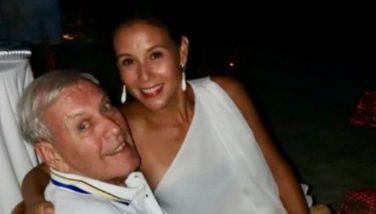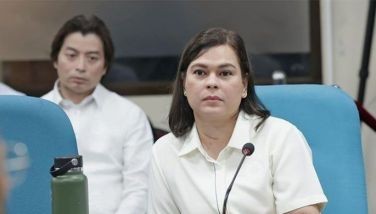Kurosawa retrospective in Manila
MANILA, Philippines - The Philippines holds the singular honor of being chosen by the Japan Foundation headquarters to host the largest Akira Kurosawa retrospective in Southeast Asia to lionize the late director’s cinematic achievements, colorful life and to commemorate globally what would have been his 100th birthday.
Mirroring the Filipinos’ continuing highest esteem of Kurosawa and to return the extraordinary favor bestowed by the Japan Foundation, three of the country’s national artists graced the Kurosawa reception hosted by the Japan Foundation-Manila, a rare feat in any local cultural gathering. They were National Artists Eddie Romero (Film) and F. Sionil José and Bienvenido Lumbera (Literature).
Shuji Takatori, director of the Japan Foundation-Manila, said the Philippines is the only country in Southeast Asia where “such a large-scale” Kurosawa retrospective, composed of 21 of his 30 films, is being held. “Smaller” Kurosawa retrospectives are being considered in other Southeast Asian countries, he said.
Regarded as the “Emperor of Japanese cinema,” the multi-awarded Kurosawa whose career as a director, producer, screenwriter and editor spanned 57 years, entered the world of Japanese film-making in 1936.
Kurosawa was born in Tokyo on March 23, 1910 and died on Sept. 6, 1998 due to stroke. He was 88.
In his remarks during the festival’s opening night held at the Cultural Center of the Philippines, Takatori said aside from Japan, similar Kurosawa retrospectives are being held in Russia, France, Italy, Monaco, US, China and South Korea.
A painter before cinema engrossed him, Kurosawa’s paintings and storyboards were also exhibited in France, Turkey, US and Japan, Takatori said.
Sadly, the great Japanese filmmaker’s paintings and sketches did not accompany the showing of his 21 films in the Manila retrospective.
The 14-day Kurosawa film festival, launched Sept. 14 with an invitational screening of the Throne of Blood had its final run at CCP on Sept. 19, then will move to the UP Film Center from Sept. 22 until Sept. 30.
The Throne of Blood (Kumonosu-jo) is a film adaption of Macbeth and has been praised by foreign critics as “the best film of all the countless cinematized Shakespearean dramas.”
The inauguration of the Kurosawa retrospective coincided with what appeared to be Takatori’s “official” introduction to the members of the Philippine diplomatic, arts and cultural communities, whose members filled the CCP Little Theater to the brims. Takatori, who arrived in the Philippines on Sept. 6, greeted the audience in formal Filipino in his speech, eliciting a thunderous applause from them.
Takatori’s predecessor, the well-loved Ben Suzuki who guided the Manila office for five years, left the Philippines on Sept. 10 to assume his new post in Tokyo. The forever-smiling Suzuki was a regular attendee of almost all important cultural events in Metro Manila, often seen quietly and keenly observing the Filipino audience in a corner but quick to strike a conversation when approached.
In an exclusive interview before the opening night, Takatori said, “In the Philippines, I hope the Akira Kurosawa Film Festival will once again invite Filipinos to rethink about the movies that this legendary director had made and directed.”
“Mr. Kurosawa studied literature, notably literary classics written by Fyodor Dostoyevsky, William Shakespeare and Maxim Gorky and they had influenced immensely his cinema,” he said.
“Because Mr. Kurosawa was a pioneer filmmaker in Japan, there is still a worldwide, continuing, vigorous and keen interest in his works which showed a wide variety of expressions, especially those influenced by Shakespeare, his adaptations of European literary classics, and his use of samurai warriors in his films,” Takatori said during the interview.
Donald Richie, considered as the expert on Japanese films, especially those of Kurosawa, explained in his book The Films of Akira Kurosawa that Kurosawa had a long history of connections with Russia, the US and France.
“Finally, fully abandoned by big-business Japan, Kurosawa had to search for funds elsewhere — Russia, the USA and France. Like (King) Lear himself, he wandered the blighted heath to get the money for (the movie) Ran. All of this was then seen by the local (Japanese) media as yet more proof of horrid Western influence on his films,” Richie wrote in his book published in 1965 by the University of California and reissued in 1998.
In Throne of Blood, the revered director transposed the plot of Shakespeare’s play Macbeth to medieval Japan.
Kurosawa made his directorial debut during World War II, with the popular action film Sugata Sanshiro (1943, Judo Saga). After the war, the critically-acclaimed film Yoidore Tenshi (1948, Drunken Angel) featured then unknown actor Toshiro Mifune in a starring role. Mifune, Kurosawa’s favorite leading actor, went on to win the Best Actor award twice at the Venice Film Festival, for his roles in Yojimbo (1961, The Bodyguard) and Akahige (1965, Red Beard).
Kurosawa’s Rashomon which premiered in Tokyo on Aug. 25, 1950, also starring Mifune, was awarded the 1951 Golden Lion Award at the Venice Film Festival.
For detailed information, please access the Japan Foundation-Manila website at www.jfmo.org.ph. Admission is free.
(Please e-mail reactions at [email protected].)
- Latest
- Trending

































